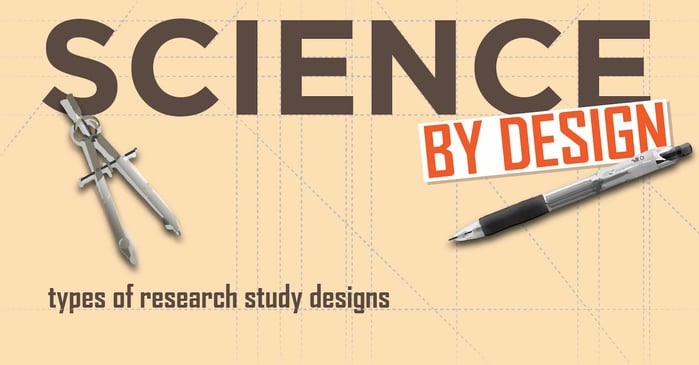Science By Design: Types of Research Study Designs

 The scientific method demands that researchers follow logical steps in their process to ensure that results are definitive. Without following these steps, including the proper design of experiments, the resulting data is not reliable. Over time, the research establishment has determined certain types of experimental designs, their advantages and disadvantages, as well as which type of design is appropriate for certain fields or contexts. Today we’ll get an overview of the types of experimental designs and how they impact the research conducted in healthcare infection control.
The scientific method demands that researchers follow logical steps in their process to ensure that results are definitive. Without following these steps, including the proper design of experiments, the resulting data is not reliable. Over time, the research establishment has determined certain types of experimental designs, their advantages and disadvantages, as well as which type of design is appropriate for certain fields or contexts. Today we’ll get an overview of the types of experimental designs and how they impact the research conducted in healthcare infection control.
Descriptive vs. Analytical: The Two Major Categories
Experimental designs are first divided into either the descriptive or analytical categories. Essentially, descriptive designs emphasize patterns in incidence or occurrence without the researcher manipulating any variables. This means that they look to describe a specific case or group of cases and pick up any patterns that could lead to greater understanding. Descriptive experiments help researchers generate hypotheses they would like to test and are great as a first step towards tackling a problem. On the other hand, analytical designs test a specific hypothesis by changing the variables, looking for specific causes or outcomes. In general, they are larger experiments that can be complex and expensive.
Types of Descriptive Study Designs
The most common types of descriptive studies are case studies/case reports, case series, and incidence reports. These studies look at a specific case – even one patient – and write up all the pertinent information on that one case for the benefit of other researchers. A case series takes the same approach to a group of similar cases, looking for patterns or relationships. Common in infection control literature, the description of an outbreak of an infectious disease at a healthcare facility would be considered a case study. The investigation would be written up to describe, in detail, the events leading up to the outbreak, how the outbreak was identified and controlled, and measures that were taken after the outbreak was over. These studies are a great help to other facilities, who can gain insight into processes and procedures from the lessons learned by another site’s experience.
Types of Analytical Study Designs
Once a researcher or team of researchers believes they have a handle on possible causes of a problem (disease, infection spread, handwashing compliance, etc.), they design an analytical study to test that hypothesis. A key feature of analytical designs is the use of a control: A group of participants that are not exposed to the variable that is being tested. In healthcare, this type of study has explicit ethics regulations in place to protect participants, and many studies have to be voluntary in order to ensure that the participant is aware of all the risks of the study.
The “gold standard” of research is the randomized controlled trial. This type of study design not only has a control group, but the assignment to the groups is random. This means that the experimenters have no say in who gets the variable being tested and who does not. This type of study is especially relevant in the pharmaceutical world, where new drugs or treatments are tested for efficacy. Once participants are accepted into the trial, they are randomly assigned to receive the treatment or to be in the control group. It is difficult and complex to design randomized controlled trials, but these studies reveal the most reliable data with the least amount of influence from bias.
Quasi-experimental designs are often used when purely randomized trials are not possible. In these cases, participants are not assigned to be in the treatment or control groups randomly, but rather by other factors (predetermined attributes, not usually simply the researchers’ choice). These designs are more vulnerable to bias or unaccounted-for influences. Some of these designs use convenience sampling, where participants are selected based on their proximity or accessibility to the research team. In the case of healthcare, using a hospital close to the research institution may be considered convenience sampling. These types of studies are not considered inferior, just subject to more questions about internal validity.
A convenience study is designed to take advantage of a unique setting that lends itself to research, a setting that is not typically available. In the case of the EOSCU trial at Sentara Leigh Hospital, for example, the construction of a new facility provided exactly such a unique opportunity. Researchers had access to one new hospital tower with EOSCU materials being used (treatment group) at the same time that the hospital’s old tower was also still in use (control group). This incredible situation allowed the researchers to have baseline historical data, a control group without EOSCU and a treatment group with EOSCU, all with the same population of patients.
Another important analytical design involves cohorts, or groups of similar participants. These groups are observed over time in an attempt to see patterns in their outcomes. Researchers can take a group of patients with a similar condition and look retroactively at their lives to look for patterns, or take a group of healthy participants and observe them over time to record incidence of health conditions in an attempt to correlate those outcomes to common elements between patients.
Other Study Designs
There are a myriad of other study designs available, including lab research studies, animal research studies, and even expert opinions such as editorials. Each has its place in the pursuit of scientific discovery and the quest for evidence. Some are better for emerging fields (e.g. an expert in infection control writes an editorial about her ideas on a subject, inspiring researchers to investigate more), while some are required for adoption of a technique or technology (e.g. laboratory studies demonstrating efficacy before a clinical trial can take place). The important thing is that the design is sound, logical, and as unbiased as possible.
Ultimately, the scientific community as a whole plays a part not only in designing quality studies, but also evaluating individual studies for quality. Journal articles are peer reviewed before publication, but every reader must also examine the research design in addition to the final results. A challenge to the general public arises can be when research is translated into a news story or used as a marketing tool. Therefore, it benefits everyone when the public is informed about what makes good science, not just what makes a good story.
Editor's Note: This post was originally published in July 2016 and has been updated for freshness, accuracy and comprehensiveness.
![EOScu Logo - Dark - Outlined [07182023]-01](https://blog.eoscu.com/hubfs/Eoscu_June2024/Images/EOScu%20Logo%20-%20Dark%20-%20Outlined%20%5B07182023%5D-01.svg)





